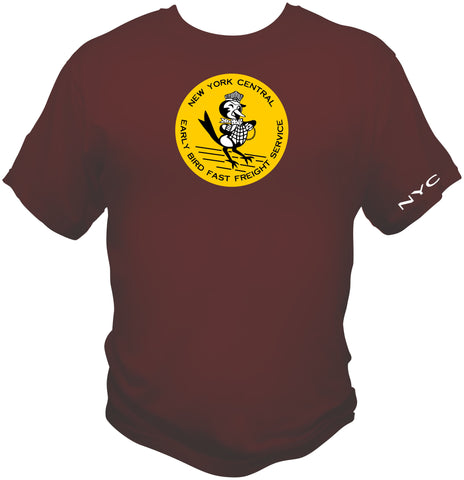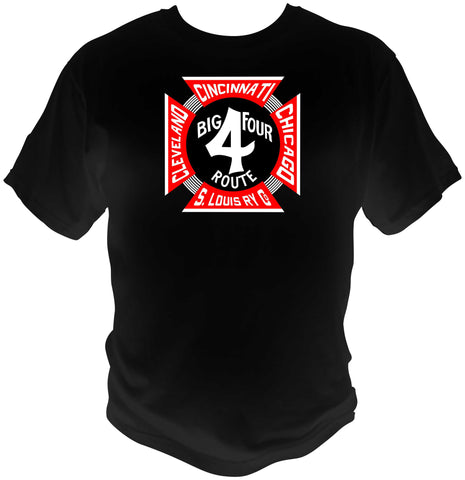
New York Central Flexi-Van Service Shirt
New York Central Flexi-Van Service Shirt
- Printed on Front
- 100% Cotton Comfort Color 6.1 oz.
- Shirt Color - Washed Denim
FLEXI-VAN " — New York Central's special brand of piggyback
service — is the company's brightest business prospect.
Revenues of $30 million to $35 million in 1961 are seen for FlexiVan by Wayne M . Hoffman, Vice President Freight Sales of the
railroad and Chairman of the road's trucking subsidiary, New York
Central Transport Company.
Envisioning a normal expansion in equipment and traffic growth
at present rates, Mr. Hoffman can see 10,000 to 12,000 vans handled per month, grossing approximately $250 per van.
Flcxi-Van's growth since its initiation on April 16, 1958, has been
spectacular. Thirty-one vans were handled that first month. By the
year-end, 4873 vans had been hauled (2157 in December). January opened the new year with 3167 vans; for all of 1959, the
total was 23,338. In August of 1960, the van count exceeded 4100,
and revenues were over $1.2 million. (Central hit its first milliondollar month in June, when Flexi-Van grossed $1.1 million.)
Does Central, with an admittedly large investment in highly
specialized equipment, make money on Flexi-Van? The answer is
"yes."' The road's management, with iron-fisted control of costs in
all segments of its business, knows to the penny what it brings
down to net. For competitive reasons, it does not disclose these
profits, but this is how Flexi-Van stacks up with boxcar operations:
A boxcar costs approximately $10,000. The specialized Flexi-Van
flatcar with two turntables costs about $15,000. Two vans cost
$8200. With bogies (wheel assemblies) for the vans, total unit cost
of Flexi-Van equipment is pushed up around $27,000. That's just
over two and a half times the investment in a boxcar.
Big Investment—But More Mileage, Bigger Loads
But Flexi-Van flats make six turnarounds a month, and their
average haul is over 800 miles compared with 247 for boxcars.
While this is using up equipment faster, gross earnings are substantially larger. It's rare that a boxcar earns much over $200 in
revenue per trip. A Flexi-Van flat, loaded with two vans, as it almost invariably is, brings in over $550. That adds up, on the basis
of six trips a month, to a gross of some $3300 compared with $400
for boxcars making two trips a month.
"We count Flexi-Van freight virtually 100 percent newly created
business — that is, recovered from highway haulers including private trucks," says Roy Milbourne, Director of Flexi-Van Sales.
"It's true that forwarder freight now moving in vans was formerly
in our boxcars but our margin of profit is much improved."
Central's Flexi-Van service is performed under Plans II, III, IV,
and V, although no use has been made as yet of Plan IV. Plan II,
of course, is rail-billed freight with the railroad performing all of
the service, including pickup and delivery. PU& D is handled by
New York Central Transport Co.
Under Plans III and IV, terminal-to-terminal rates are charged
shippers who furnish, under Plan III, their own vans or, under
Plan IV, both vans and flatcars, and perform or hire all their terminal services.
Central does not offer, and does not plan to offer, Plan I service
under which common carrier truckers — railroad competitors — are
the railroad's customers for the road-haul. Central does, however,
have a Plan V service on Long Island with so-called "vicinity carriers" which have limited area rights. Plan V permits rail and
motor carriers to perform combined services under joint rates and
routes.
On October 15, Central also expanded Plan V services for hauling new automobiles via highway auto carriers aboard flatcars
leased from North American Car Corp. The railroad also handles
new autos in special Flexi-Van haulers from terminal to terminal,
as well as shippers' dock to consignee's door on commodity rates.
"Super-Vans" Serve Four Cities
Flexi-Van service was given added impetus when Central initiated new, solid "Super-Van" trains last spring between New York
and Chicago on passenger train schedules. Recently, this service
was extended to Boston and St. Louis. Vans are set on their wheels
in terminal areas in time for delivery to customers' doors before
the next business day begins.
Twenty Flexi-Van terminals virtually blanket the New York
Central Railroad system. NY C Transport performs the terminal
and PU& D services.
N Y C now interchanges with the Milwaukee Road, Santa Fe,
Burlington, MoPac, and L&N , is negotiating with several other
carriers interested in Flexi-Van.
Central has also begun interchange with States Marine Lines,
American President Lines, U.S. Lines, and Transamerican Steamship Co. Foreign freight shipments are going via Flexi-Van to
Korea, Japan, North Africa, and North Europe.
(Central's containers are 35, 36 and 40 feet in length, and include end-door, side-door and open-top units, insulated and
mechanically refrigerated vans, and auto racks.)
The road's management is convinced that side-loading of "boxes
without wheels," i.e., "containerization" is the most efficient of all
piggyback systems, and believes the most efficient side-loading
system up to now is Flexi-Van. However, Central officials also
emphasize that they want to go along with, or initiate, further
technical improvements.
Currently, Central is looking into straddle and crane lifts that
could load or unload any kind of boxes or trailers from the side,
and will take delivery shortly of a new, improved Flexi-Van flatcar.
To keep up with the rapidly increasing Flexi-Van volume, Central will spend substantial amounts in 1961 to expand Flexi-Van
terminals and equipment. •
P
*Image is a representation and may not be exact




